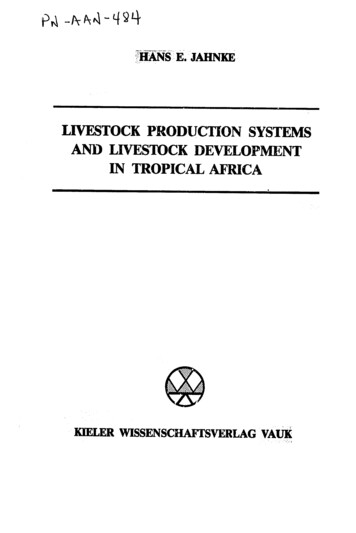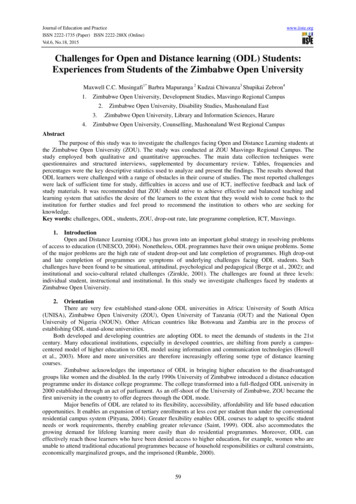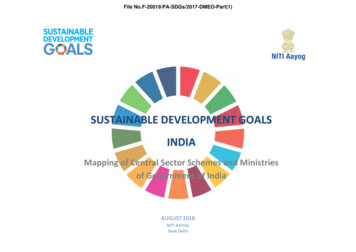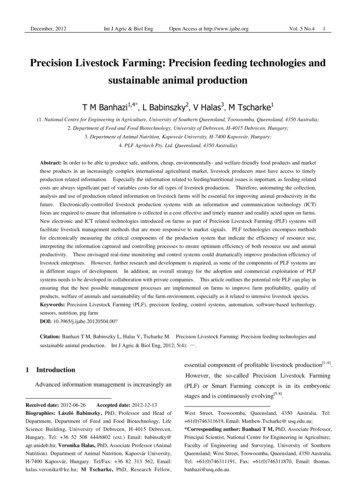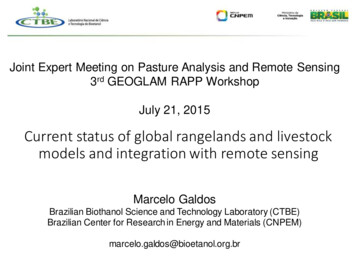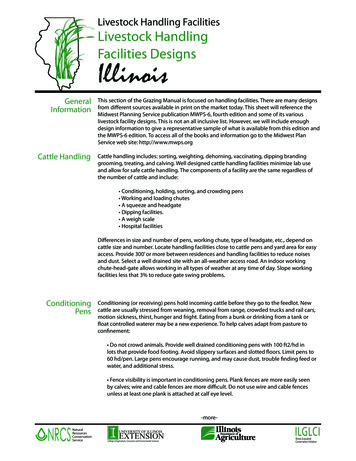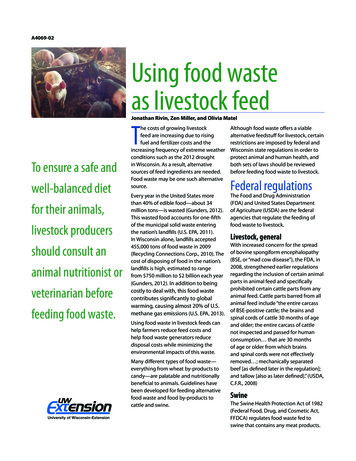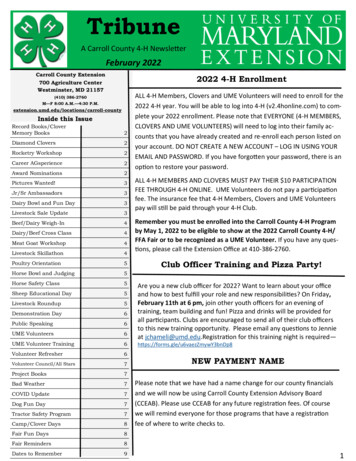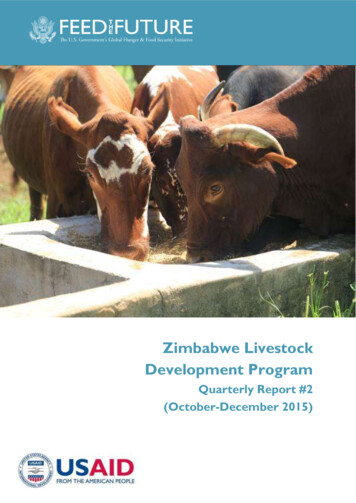
Transcription
Zimbabwe LivestockDevelopment ProgramQuarterly Report #2(October-December 2015)
Fintrac Inc.www.fintrac.cominfo@fintrac.comUS Virgin Islands3077 Kronprindsens Gade 72St. Thomas, USVI 00802Tel: (340) 776-7600Fax: (340) 776-7601Washington, DC1400 16th Street, NW,Suite 400Washington, D.C. 20036 USATel: (202) 462-8475Fax: (202) 462-8478Feed the Future Zimbabwe Livestock Development Program (FTFZ-LD)5 Premium CloseMt. Pleasant Business ParkMt. Pleasant, HarareZimbabweTel: 263 4 338964-69ftfz-ld@fintrac.comwww.fintrac.comAll Photos by FintracJanuary 2016This publication was produced for review by the United States Agency for International Development(USAID). It was prepared by Fintrac Inc. under contract AID-613-C-15-00001 with USAID/Zimbabwe.
Feed the Future Zimbabwe Livestock Development Program Quarterly Report #2CONTENTSACRONYMS.i1. EXECUTIVE SUMMARY .12. INTRODUCTION .32.1 BACKGROUND. 32.2 GOALS & OBJECTIVES. 32.3 IMPLEMENTATION APPROACH . 42.4 TARGET GEOGRAPHIC ZONES . 53. ACTIVITIES .63.1 BENEFICIARIES & GEOGRAPHICAL COVERAGE. 73.2 SALES AND INCOME . 83.2.1Milk and Dairy Products . 93.2.2Beef Product Sales . 103.3 PRODUCTIVITY. 123.3.1Beef . 123.3.2Dairy . 173.3.3Partnerships . 223.4 NUTRITION, WASH, AND HYGIENE . 233.5 BUSINESS DEVELOPMENT AND FINANCIAL LINKAGES . 253.6 LOCAL CAPACITY DEVELOPMENT. 264. ENVIRONMENT.275. GENDER .29MEASURING GENDER IMPACT AND WOMEN’S EMPOWERMENT . 29LEADERSHIP. 30ACCESS TO FINANCE, CREDIT, AND MARKETS . 316. LESSONS LEARNED .327. CHALLENGES .338. ACTIVITIES PLANNED FOR NEXT QUARTER.35ANNEX 1: SNAPSHOTS. A1ANNEX 2: ILLUSTRATIVE INDICATORS . A5ANNEX 3: LIST OF BUYERS . A10ANNEX 4: LIST OF INPUT SUPPLIERS . A11Prepared by Fintrac Inc.
Feed the Future Zimbabwe Livestock Development Program Quarterly Report HEADPrepared by Fintrac Inc.African Breeders Services Total Cattle Management Ltd.Client Impact and Results Information SystemDivision of Livestock Production and DevelopmentDepartment of Veterinary ServicesEnvironmental Monitoring and Management PlanFood and Agriculture OrganizationFoot & Mouth DiseaseGood Agricultural Practice(s)Good Animal Husbandry Practice(s)HouseholdMinimum Acceptable DietMilk Collection CenterMonitoring and EvaluationMicrofinance InstitutionNongovernmental OrganizationNatural Resource ManagementPesticide Evaluation Report and Safer Use Action PlanRural District CouncilUnited States Agency for International DevelopmentWater, Sanitation, and HygieneUSAID Zimbabwe Agricultural Income and Employment Development ProgramZimbabwe Applied Health Education and Developmenti
Feed the Future Zimbabwe Livestock Development Program Quarterly Report #21. EXECUTIVE SUMMARYThis quarterly report (October-December 2015) is the second for the Feed the Future ZimbabweLivestock Development program that is funded by USAID/Zimbabwe under contract AID-613-C-1500001 and implemented by Fintrac Inc. The following report summarizes activity achievements,results, and impact from the second quarter of this 60-month contract. During this period, programactivities primarily concentrated on completing and analyzing the baseline survey and setting up fieldactivities and operations. Challenges remained from Foot and Mouth Disease (FMD) and the poorstate of rangelands due to the drought in the 2014/15 agricultural season; and these problems werecompounded by the erratic, poorly distributed, and inadequate rains between October andDecember 2015. At the start of the 2015/16 agricultural season, livestock in all target areas facedsevere food and water shortages with cattle deaths reported in most areas. Farmers have curtaileddryland fodder production because crop establishment has failed or performed poorly because ofinadequate moisture.Direct technical assistance from the Feed the Future Zimbabwe Livestock Development programaddresses humanitarian and food security needs to not only increase smallholder farmers’ incomes,but also generate income for others in the community through employment in the agriculturalsector. Program interventions raise production and productivity; add value to products; expandmarket access; and increase the availability of credit and finance at all levels in the value chain. Inaddition, participating households receive training in and are exposed to good nutrition and hygienepractices. The program is also promoting social inclusion of women and youth, and environmentalstewardship.To maximize outreach and ensure sustainability, intervention partners with commercial companiesand non-governmental organizations (NGOs). Partnerships with financial organizations, privatesector traders, processors, input suppliers, and technical service providers constitute a key part ofthe program approach to commercializing small-scale beef and dairy farmers. Negotiations continuedwith identified potential partners for cost-sharing partnerships.Specifically during the period under review: The program completed a baseline survey among households in the targeted communities; basedon these findings and an analysis of the results, the program adjusted targets and technical areasfor intervention. A needs assessment for LEAD Trust - the organization implementing the Feed the FutureZimbabwe Crop Development program - was conducted to identify capacity buildingrequirements and a work plan was completed for implementation.The meetings to finalize the MOUs with Shurugwi local authorities were conducted andintroductory meetings continued to be held with farmers, local leadership, other donorprograms, and some buyers of dairy and beef products in all target areas. The team continued with economic and market analysis to help identify specific activities foreach target site. On-the-ground assistance included training, technical assistance, credit, input,market linkages for beef farmers after pen fattening of their cattle, fodder production, diseasecontrol, and supplementary feeding.A draft gender strategy was submitted for discussion and approval to USAID/Zimbabwe.The subcontract with African Breeders Services – Total Cattle Management (ABS-TCM) wassubmitted to USAID/Zimbabwe for approval.By the end of the period under review, 750 beef and dairy rural households, or 856 smallholderfarmers, have benefitted from Feed the Future Zimbabwe Livestock Development programinterventions since inception in June 2015. Of these households, 33 percent (250 households)are engaged in dairy farming and 11 percent (28 households) are small-scale commercial farmers.Communal dairy and beef households constitute 96 percent of the program beneficiaries todate.Prepared by Fintrac Inc.1
Feed the Future Zimbabwe Livestock Development Program Quarterly Report #2 Smallholder farmers working with the program delivered 83,928 liters of milk valued at 43,494to the three milk collection centers (MCCs) as well as processors Dendairy and Kershelmar inprogram focus areas during the quarter compared to 85,838 liters worth 47,106 in the lastquarter. Deliveries declined because of low production due to lack of adequate feed and somecows drying off.Compared to 170 pen-fattened animals valued at 55,554 sold in the previous quarter, this timearound 302 pen-fattened animals from 204 farmers valued at 174,662 were sold from 26 Feedthe Future Zimbabwe Livestock Development program’s supervised feedlots to formal buyers.Gross earnings per animal were 578.35 compared to 326.78 in the last quarter due to firmingprices and improvement in quality.A total of 571 beef farmers, of which 45 percent were women, participated in beef trainingsessions across the nine beef focus areas during the period under review. Pen fattening,good animal husbandry practices (such as supplementary feeding), and beef marketing wereamong the most popular topics with farmers in this quarter. The program promoted fodder production by setting up 86 demonstration plots on farmers’fields to showcase good agricultural practices (GAPs) in fodder production for wider adoptionby surrounding farmers. Training and technical assistance helped establish forage sorghum, velvetbean, leucaena, and mulberry plantations. However, in all focus areas, low rainfall severelyaffected fodder establishment. A total of 285 dairy farmers (170 males and 115 females) received training and technicalassistance on animal nutrition and health, quality control, marketing, and GAHPs. Fifty-sixpercent of the dairy farmers trained were from Gokwe South. The training and technicalassistance aims to increase milk yields from the baseline figure of 2.61 liters per day per cow toabove 12 liters per day per cow; normalize the lactation periods to about 300 days; and set thecalving intervals to between 12 and 13 months. The program facilitated access to credit for 194 farmers, who altogether received loans fromfinancial institutions worth 51,194.32. Women constituted 31 percent of these farmers, andaccessed 13,671.71 in loans that primarily went to pen fattening their animals. Of note, fourmale dairy farmers received credit worth 2,000 for improving their paddocks.In this quarter, 204 feedlot farmers sold 302 of their value-added animals through Sabie Meats,Montana Carswell Meats, Koala Park, and Heads and Hooves. Of the 204 farmers, 32 percentwere women. Forty-seven milk producers were linked to MCCs (Gokwe and Umzingwane) toease aggregation and for better handling of milk; of which, 38 percent were female farmers.Feed the Future Zimbabwe Livestock Development program is deliberately promoting theuptake of productive and profit-enhancing technology among female farmers. This quarter,women accounted for 32 percent (65) of the 204 program beneficiaries who adopted andapplied pen-fattening technology to increase the value of their marketed beef animals. Resultsindicate that women excelled in this technology compared to their male counterparts as theywere meticulous in putting into practice the training and technical assistance they received fromthe program. Going forward, planned activities include 1) finalizing and initializing the subcontract with ABS-TCM;2) finalizing the gender implementation strategy; 3) drafting a nutrition strategy; 4) training andtechnical assistance to beneficiaries at the program’s 86 centers of excellence; and 5) implementingthe first phase of the annual survey to collect data on performance indicators.Prepared by Fintrac Inc.2
Feed the Future Zimbabwe Livestock Development Program Quarterly Report #22. INTRODUCTION2.1 BACKGROUNDFeed the Future Zimbabwe Livestock Development program began June 23, 2015 and runs throughJune 22, 2020; over this time, the program works to reduce rural poverty and improve householdfood security among smallholder producers through increased production, productivity, and marketlinkages in the beef and dairy cattle sectors. Activities to commercialize small-scale beef and dairyfarmers on communal and non-contested land include the following: Raising efficiencies in beef and dairy production systems. Facilitating access to inputs, finance, and credit. Linking producers to local, national, regional, and international buyers.Training farmers to adopt good agricultural, business, and animal husbandry practices. Training farmers to adopt good nutrition and hygiene practices.Strengthening the capacity of local organizations to implement agricultural developmentprograms.The program is building demand for smallholder-produced beef and dairy products by focusing onquality, continuity of supply, and cost-competitiveness. Feed the Future Zimbabwe LivestockDevelopment program also collaborates with Feed the Future Zimbabwe Crop Development andother donor programs to provide specialized technical support to produce nutritious crops thatsustainably increase the availability of these foods for beneficiary households. Fintrac is implementingFeed the Future Zimbabwe Livestock Development program with subcontractor ABS-TCM inaddition to assistance from local private companies, NGOs, the Department of Livestock andVeterinary Services (DLVS), and other government departments involved in the beef and dairy valuechains.2.2 GOALS & OBJECTIVESPrimarily, Feed the Future Zimbabwe Livestock Development program seeks to reduce poverty andincrease food security among 3,000 beef and 2,000 dairy smallholder farmers in Natural Regions III,IV, and V. The program focuses on increasing production, productivity, and market linkages of beefand dairy farmers to improve their food security, incomes, and nutrition status. The program willaccomplish this goal through the achievement of three intermediate results:1. Increased agricultural production and productivity of targeted beef and dairysmallholder farmers through greater market linkages; access to appropriate credit andfinance; adoption of GAPs and technologies; and investment.2. Improved hygiene and nutrition-related behaviors through training on goodhousehold nutrition, hygiene, and sanitation practices, and exclusive breastfeeding.3. Increased organizational capacity of local organizations to implement USAID andagricultural development programs via capacity building and transferring skills; sharing bestpractices; and attracting new investments in private sector organizations partnering withboth Feed the Future Zimbabwe Livestock Development and Feed the Future ZimbabweCrop Development.The Feed the Future Zimbabwe Livestock Development program concentrates on profitable beefand dairy production and income generation through appropriate and sustainable interventions thatimprove the livelihoods of vulnerable livestock owners. These activities will move rural families fromsubsistence to commercial farming and increase their net worth through investment in cattle andother on-farm productivity-enhancing assets.Prepared by Fintrac Inc.3
Feed the Future Zimbabwe Livestock Development Program Quarterly Report #22.3 IMPLEMENTATION APPROACHThe results framework below summarizes the Feed the Future Livestock Development programimplementation approach. Interventions will sustainably raise production, productivity, and incomesfrom smallholder beef and dairy systems; improve hygiene practices and behaviors; increase theavailability and utilization of nutritious foods; expand market access and availability of credit andfinance across value chains; add value to beef and dairy products; and boost agricultural investmentas well as adoption of best organizational practices by local implementing organizations.Figure 1: Results Framework SummaryGOAL: REDUCE POVERTY AND IMPROVE FOOD SECURITY AND NUTRITIONIncreased organizational capacity oflocal implementing organizationsAdoption of bestorganizationalpracticesPartnershipsIncreased Agricultural Production,Productivity and IncomesAdoption of GAPsand GAHPsStandardsAccess toFinance, Creditand InvestmentBDSEnvironmentImproved nutrition and hygienepractices and behaviorsImproved hygienebehaviorsMarket LinkagesAccess to and utilization ofnutritious foods andexclusive breastfeedingGenderTo maximize outreach and ensure sustainability, the Feed the Future Zimbabwe LivestockDevelopment program is partnering with commercial companies, NGOs, and relevant governmentdepartments to carry out interventions. Partnership with relevant government departments enabledeasy entry into target areas and entails sharing of technical information and training platforms. Inaddition these departments form part of the program’s exit strategy.Developing commercial partnerships through a national network of agribusinesses strengthensfarmers’ access to markets with fair prices; provides working capital and finance at realistic rates;supplies inputs efficiently; and provides extension and training to growers as an embedded cost. Thepartnerships focus on establishing service provision options at market rates. During its first half ofthe year, the program has been engaged in the following: Identifying high-potential and viable beef and dairy agribusiness hubs in targeted regions. Ensuring competitiveness of smallholder beef and dairy sectors by improving productivity andefficiency. Facilitating and fostering linkages with formal and informal buyers to increase demand forsmallholder beef and dairy products. Activities also seek to improve quality, increase quantity,and assure reliability of supply and logistics.Prepared by Fintrac Inc.4
Feed the Future Zimbabwe Livestock Development Program Quarterly Report #2 Creating more sustainable markets and harnessing new private investment in smallholder beefand dairy by supporting innovative business models in the formal and informal sectors. Bringing more market players to engage livestock farmers in identified agribusiness hubs.Expanding the availability of inputs for beef and dairy farmers throughout identified agribusinesshubs by creating commercial partnerships with input suppliers and introducing low- to no-costinterventions that improve productivity, animal health, and nutrition. Increasing access to finance for all value chain actors to facilitate investment.Improving overall household health and nutrition through improved dietary diversity (e.g. byincorporating livestock products) and trainings on household nutrition and proper sanitation. Building the capacity of local businesses, producer groups, and other community institutionsthrough the program and its sister program, Feed the Future Zimbabwe Crop Development. Providing demand-driven training and technical assistance to address site-specific challenges. Identifying opportunities that allow program beneficiaries to generate high returns with minimalresources.2.4 TARGET GEOGRAPHIC ZONESDistricts and preliminary wards forbeef and dairy interventions wereselected based on the number ofhouseholds engaged in beef anddairy activities; potential for marketdevelopment through private sectoralliances; proximity to DevelopmentFood Assistance Programs andother donor activities; baselineincome and herd size requirements;potential for a high number offemale-headed households; andlogistical and operational cost.Figure 2: Geographic Focus AreasPrograminterventionshavetargeted irrigation schemes, ZimAIED-established beef and dairyhubs, and existing MCCs in NaturalRegions III, IV, and V. The programwill capitalize on the establishedinteractions of farmers, buyers,input suppliers, and service providers around these hubs to strengthen links between farmer groups,buyers, input suppliers, and service providers. Technical assistance will further cement these linkagesinto strong business partnerships.During the quarter under review, the team implemented program activities at sites in Hwange,Lupane, Nkayi, (Matabeleland North) Umzingwane, (Matabeleland South) Gokwe South, Kwekwe,Shurugwi, Chirumhanzu (Midlands), and Chipinge (Manicaland) districts and met with farmers, localleadership, other donor programs, and private sector players. Combined with its ongoing economicand market analysis, the team continued to refine its interventions for each target site. Selection ofthe most promising sites for beef and dairy will continue in the next quarter, and will be guided bythe program’s overarching commercialization approach: Market potential – accessibility, size, growth potential, buyer interest Rapid expected returns on labor and capitalCapital requirements and access to credit and finance Availability of infrastructure and facilitiesPrepared by Fintrac Inc.5
Feed the Future Zimbabwe Livestock Development Program Quarterly Report #2 Availability of capable commercial partnersOverall competitiveness in product cost and quality – including analysis of grower knowledgeand climatic and agronomic factors3. ACTIVITIESActivities occurred in Gokwe South, Kwekwe, Chirumhanzu, Shurugwi, Gweru, Umzingwane,Chipinge, Hwange, Lupane, and Nkayi. Interventions included completing the baseline survey in allareas; setting up 86 farmer (32 female and 54 male) run centers of excellence to conduct farmerfield schools; arranging producer credit for pen fattening and dairying; providing marketingassistance; fostering group development; and supplying technical assistance.Dry weather conditions and intermittent rains in all focus areas characterized the reporting period.Cumulative rainfall received at the end of the quarter did not adequately support crop life. Table 3below summarizes the cumulative rainfall in program focus areas up to the end of December 2015.The low rainfall in all districts affected fodder establishment, the main planned activity for thequarter. Many districts either never commenced planting of the fodder crops or aborted the processbecause of inadequate moisture. Most crops that were established succumbed to the dry spell,except for the velvet beans in Umzingwane.Table 3: Total Rainfall Received (mm) and its Effects on Fodder Demonstration Plots inProgram Areas, October – December 2015Rainfall Received Cumulativeby Month (mm)Areato DateFodder Crop Status CommentOct. Nov. Dec. nje24143Umzingwane141.625.5Gokwe wards13,15,16, NkayiGermination was 65% dueto inadequate moisture;55maize was approachingpermanent wilt33Fodder in Musikavanhugrowing well86 Not yet planted68.1 Planted velvet beans onlyPoor - Fair germination130.4 and crop stand poor to fairin most areasGermination was good but173.5 establishment poor givenprolonged dry spellGermination was good but101 establishment poor givenprolonged dry spellNo fodder demos122establishedCrops were approachingpermanent wilting point;resuscitated by the wet spellreceived in first week of January2016,Only sun hemp was establishedin the irrigation scheme; othercrops outside the irrigation area write offFarmers still struggling tosuccessfully establish a crop.Velvet beans have managed tosurvive the dry spellDry spell with unevengermination and wilting cropSome demonstration plotssuccessfully recovered from theeffects of the dry spellSome demonstration plotssuccessfully recovered from theeffects of the dry spellThe following sections describe Feed the Future Zimbabwe Livestock Development activities brieflyin nine categories that reflect our technical approach and objectives: Beneficiaries – number, gender balance, geographical spread Sales and incomes – amount of new money earned by beneficiariesPrepared by Fintrac Inc.6
Feed the Future Zimbabwe Livestock Development Program Quarterly Report #2 Productivity – direct interventions in beef and dairyMarket access – research, analysis, planning, and new business development Finance and credit – microcredit support for smallholder beef and dairy farmersNutrition and hygiene activities Gender – cross-cutting activities to support the inclusion of women and youthEnvironment Organizational capacity development3.1 BENEFICIARIES & GEOGRAPHICAL COVERAGEA total of 750 rural households or 856 smallholder farmers1 have benefited from interventions sinceJune 2015 (Table 3.1.1). Of these households, 33 percent (250 households) are engaged in dairyfarming and 11 percent of the dairy households (28 households) are small-scale commercial farmers.Communal dairy and beef households constitute 96 percent of the program beneficiaries to date.Farmers received training and technical assistance in beef and dairy production and productivity, andwere linked to credit and input suppliers and markets. Women constituted 43 percent ofbeneficiaries, with 69 percent of the women participating in beef activities compared to 29 percentin communal dairy activities and 2 percent in small-scale commercial dairy. Section 5 describes infurther detail how the program aims to include more women and youth in profitable enterprisestraditionally dominated by men.Table 3.1.1: Geographical Distribution of Households, July - December 2015ValueChainBeefDistrictNaturalQ1 (July - Sept)Q2 (Oct - Dec)CumulativeRegion Female Male Total Female Male Total Female MaleTotalChipingeV88481361786103105134239Gokwe 5231015259454148129 000161834161834Gokwe UmzingwaneIV571200057128182687 437336319226222810575180219 351570324426750Sub TotalCommunalDairySub TotalSmall-scale Gokwe SouthCommercial ShurugwiDairyUmzingwaneSub TotalGrand TotalSource: CIRIS1 The number of rural households was derived from the number of individual farmers trained. The annual survey shouldverify that 14 percent of households trained have at least two trainees from the same household.Prepared by Fintrac Inc.7
Feed the Future Zimbabwe Livestock Development Program Quarterly Report #2Beef interventions occurred in all districts covered by the baseline survey, except Gweru as it istargeted for the next quarter. Dairy activities concentrated in the traditional smallholder dairy areas(Gokwe South, Shurugwi, and Umzingwane). The program is also formulating strategies to move intothe non-traditional dairy areas of Chipinge South and Chirumhanzu.With six months into program implementation, Feed the Future Zimbabwe Livestock Developmentis 33 percent (250 households) shy of its annual beneficiary target of 750 rural households for beef.As for dairy, the program has reached 50 percent of its 500 rural household target (Table 3.1.2). Theprogram is on course to meet its beef and dairy beneficiary targets. The last two quarters of FY2016will concentrate on enrolling more dairy farmers by identifying potential beef-dairy households,2resuscitating dormant dairy producers,3 and identifying marketing opportunities (e.g. building capacityof existing MCCs to deliver quality service to members and engaging new market players).Table 3.1.2: Beneficiary Households VarianceValue ChainBeefDairyTotalFY16 TargetAchievement to date7505001,250Variance500250750-250 (-33%)-250 (-50%)-500 (-40%)Source: CIRISTable 3.1.3 details the types of assistance beneficiaries received from the program. A total of 856smallholder farmers were trained as individuals and in groups, of which 43 percent were women.Among the trainees, 571 received beef trainings and 285 received dairy trainings. These trainingscovered farmers in Chipinge, Chirumhanzu, Gokwe South, Hwange, Kwekwe, Lupane, Nkayi,Shurugwi, and Umzingwane districts. Also, some farmers were linked to input and product marketsand 194 farmers received input loans (credit) for pen fattening and dairy production.Table 3.1.3: Program Interventions, June - December, 2015ActivitiesTrainingsand TAFarmersreceivingcreditFarmerslinked
Feed the Future Zimbabwe Livestock Development Program Quarterly Report #2 Prepared by Fintrac Inc. i ACRONYMS ABS-TCM African Breeders Services Total Cattle Management Ltd. CIRIS Client Impact and Results Information System DLPD Division of Livestock Production and Development DVS Department o
